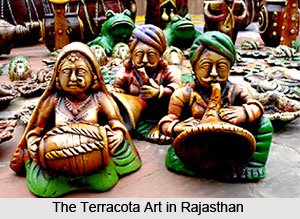 Terracota Art in Rajasthan is of much prominence in the state because for these villagers the worship of their terracotta deities is as fundamental and necessary to survival as the water pitcher which contains and carries water from the well to their homes in this dry land. It is said that Terracota Art in Rajasthan has been of outstanding value right from the Mesolithic Age till the Gupta period. The terracotta art works of Rajasthan are also known for its intricate workmanship.
Terracota Art in Rajasthan is of much prominence in the state because for these villagers the worship of their terracotta deities is as fundamental and necessary to survival as the water pitcher which contains and carries water from the well to their homes in this dry land. It is said that Terracota Art in Rajasthan has been of outstanding value right from the Mesolithic Age till the Gupta period. The terracotta art works of Rajasthan are also known for its intricate workmanship.
Shrines can be found everywhere in rural India: in small dark caves, in the middle of dense forests, on high hill tops, in the roots of gigantic trees, in open fields, by the wayside or in the village square, at the threshold of a home and even within the living space or courtyard of a family.
In Rajasthan the families of the potter use two sources of clay from local ponds, a coarse one for making the plaques and a plastic one for throwing. Donkey dung is collected by the women from the fields and added to the coarse clay in the ratio of 1:3 to make it suitable for modelling. As with all potter families, there are strict divisions of labour within its members.
In Rajasthan terracotta images of the mother goddess depicted in various incarnations are widely worshipped by the Tribals. As Goddess Durga she sits astride a lion, as Chamunda an elephant, mounted on a buffalo as Kalika or holding a sword as Aawanmata. The serpent god Nagadev has been worshipped in India since ancient times and the images usually have a central figure flanked with several snake consorts. Another popular male deity the potters make is Bhairav represented by two images indicating the deity`s omnipotence - Kala Bhairav, and Gora Bhairav, the dark and the fair. Bhairav, who bears a distinct resemblance to the Lord Shiva, holds a trident, a thunderbolt, a skull and a noose. His mount is a dog and his image is installed in every shrine with that of other gods and goddesses. Kala, cunning and strong willed, is propitiated by the offering of liquor and animal sacrifice while Gora, mild, compassionate and vulnerable, is offered sweetmeats.



















